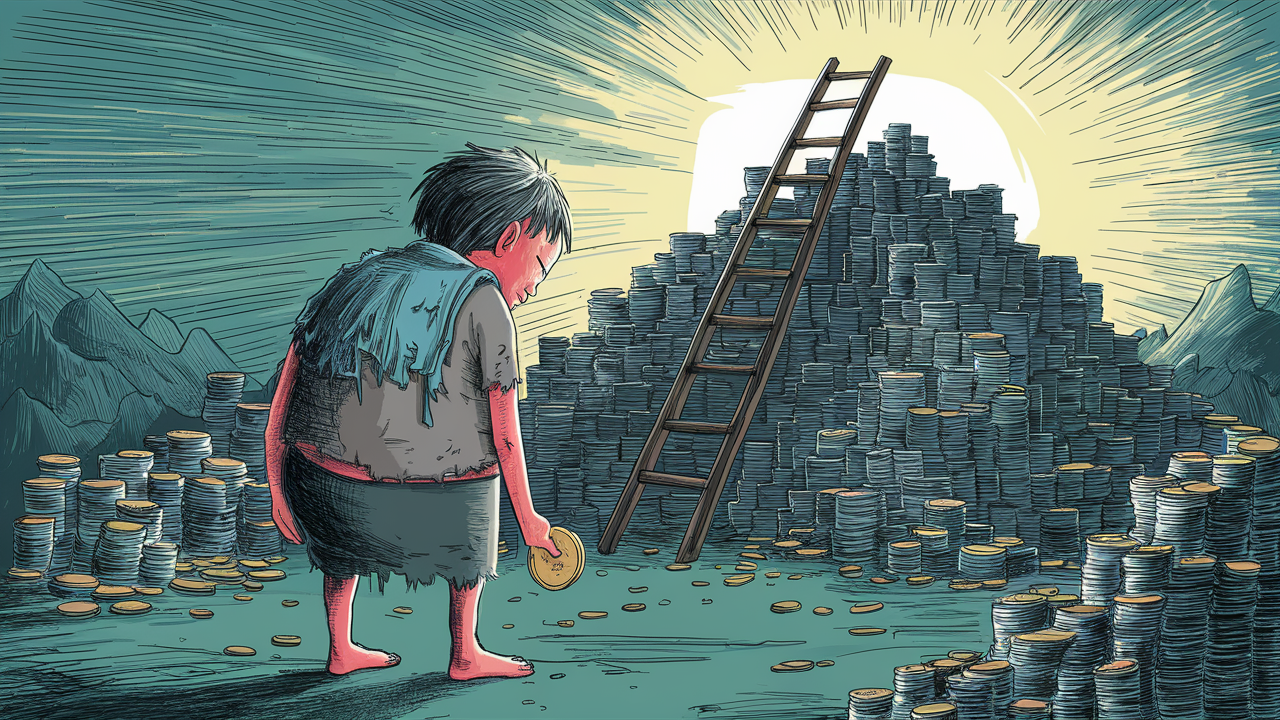-
Posted on: 16 Jul 2024

-
Facing overwhelming debt when you have limited income feels like an impossible mountain to climb. This guide offers practical, actionable strategies for those struggling financially, proving that debt payoff is achievable even on a tight budget.
Understanding Your Debt Landscape
The first and most crucial step in tackling debt, especially when finances are strained, is to gain a crystal-clear understanding of exactly what you owe. Many people avoid this step because it can be daunting, but knowledge is power. Without a comprehensive overview, you're essentially navigating blindfolded, making it difficult to chart a realistic course forward.
Inventorying All Your Debts
Sit down with a pen and paper, a spreadsheet, or a dedicated debt tracking app. List every single debt you have. This includes credit cards, personal loans, student loans, medical bills, car loans, payday loans, and even money owed to friends or family. For each debt, record the following vital information:
- Creditor Name: Who do you owe money to?
- Current Balance: The exact amount outstanding.
- Interest Rate (APR): This is critical for prioritizing. Higher interest rates cost you more money over time.
- Minimum Monthly Payment: The smallest amount you must pay each month to avoid late fees and penalties.
- Due Date: When is the payment due?
Calculating Your Total Debt Burden
Once you have this information compiled, sum up all the current balances to get your total debt burden. This number can be shocking, but it's essential for setting realistic goals. In 2025, the average American household debt continues to be a significant concern. According to recent reports, the average U.S. household carries over $60,000 in non-mortgage debt, with credit card debt alone averaging around $10,000. For those with lower incomes, this figure can represent a much larger percentage of their annual earnings, making the challenge even more pronounced.
Assessing Your Financial Snapshot
Alongside your debt inventory, you need to understand your current financial reality. This means looking at your income and your essential expenses.
- Monthly Income: What is your total take-home pay after taxes and deductions? If you have variable income, calculate an average based on the last 6-12 months, or use a conservative estimate.
- Essential Monthly Expenses: List all non-negotiable expenses. These typically include housing (rent/mortgage), utilities (electricity, gas, water), food, transportation (gas, public transit, car insurance), essential healthcare costs, and minimum debt payments.
Mastering Your Budget: The Foundation of Debt Payoff
A budget is not a restriction; it's a roadmap. For individuals with limited income, a meticulously crafted budget is the single most important tool for debt payoff. It provides clarity, control, and a clear path to allocating every dollar purposefully.
Creating a Realistic Zero-Based Budget
A zero-based budget means every dollar of your income is assigned a job. Income minus expenses and savings/debt repayment should equal zero. This approach forces you to be intentional with your spending.
- Calculate Total Monthly Income: As determined in the previous step.
- List All Expenses: Categorize them into needs (housing, food, utilities, transportation, debt minimums) and wants (entertainment, dining out, subscriptions).
- Allocate Funds: Assign a specific dollar amount to each category. Be honest and realistic.
- Adjust and Refine: If your expenses exceed your income, you must make cuts. If you have money left over, allocate it to debt repayment or savings.
Tracking Your Spending Diligently
Creating a budget is only half the battle; tracking your spending is the other. You need to know where your money is actually going.
- Manual Tracking: Use a notebook or a spreadsheet to log every transaction.
- Budgeting Apps: Many free and low-cost apps can link to your bank accounts and credit cards to automatically categorize spending. Popular options include Mint, PocketGuard, and YNAB (You Need A Budget), though YNAB has a subscription fee.
- Envelope System: For cash-heavy spenders, the envelope system can be very effective. Allocate cash for variable expenses (groceries, entertainment) into separate envelopes. Once an envelope is empty, you stop spending in that category for the month.
Identifying Areas for Savings
When income is low, finding areas to cut back requires creativity and sometimes sacrifice.
- Review Subscriptions: Cancel unused streaming services, gym memberships, or magazine subscriptions.
- Reduce Dining Out: Eating at home is almost always cheaper than eating out. Pack lunches and make coffee at home.
- Lower Utility Bills: Be mindful of energy consumption. Unplug electronics when not in use, use energy-efficient bulbs, and adjust your thermostat.
- Cut Entertainment Costs: Look for free activities like visiting parks, libraries, or community events.
- Shop Smarter for Groceries: Plan meals, buy in bulk when feasible, use coupons, and choose generic brands.
Boosting Your Income: Small Gains, Big Impact
When your budget is already stretched thin, increasing your income becomes a critical component of debt payoff. Even small, consistent increases can make a substantial difference over time.
Exploring Side Hustles and Gig Work
The gig economy offers numerous opportunities to earn extra money on your own schedule. Consider:
- Delivery Services: Driving for companies like DoorDash, Uber Eats, or Instacart.
- Ridesharing: Driving for Uber or Lyft if you have a reliable car.
- Freelancing: Offering skills like writing, graphic design, virtual assistance, or web development on platforms like Upwork or Fiverr.
- Task-Based Apps: Services like TaskRabbit allow you to offer help with various tasks, from furniture assembly to moving.
- Pet Sitting/Dog Walking: If you love animals, this can be a rewarding way to earn extra cash.
- Selling Crafts or Baked Goods: If you have a talent for making things, consider selling them online or at local markets.
Selling Unused Items
Go through your home and identify items you no longer need or use. Clothes, electronics, furniture, books, and collectibles can all be sold online through platforms like eBay, Facebook Marketplace, Poshmark, or at local consignment shops or pawn shops. This can provide a quick influx of cash that can be immediately applied to your highest-interest debt.
Negotiating a Raise or Seeking a Higher-Paying Job
While not always immediately feasible, consider if there's an opportunity to increase your primary income.
- Negotiate a Raise: If you've been a valuable employee, research salary benchmarks for your role and prepare a case for a raise.
- Seek New Employment: Update your resume and actively look for positions that offer better pay and benefits. Even a small increase in your hourly wage or salary can significantly impact your debt repayment capacity.
Leveraging Tax Credits and Benefits
Ensure you are claiming all eligible tax credits and government benefits. Programs like the Earned Income Tax Credit (EITC) can provide significant refunds for low-to-moderate income individuals and families. Researching federal, state, and local assistance programs can uncover resources you might be eligible for, freeing up income that would otherwise be spent on essential needs.
Effective Debt Reduction Strategies for Low Income
Once you have a clear budget and are looking for ways to increase your income, you can start focusing on specific debt reduction strategies. The most effective approach depends on your individual debt profile.
The Debt Snowball Method
This popular method focuses on psychological wins. You pay the minimum on all debts except the smallest one, which you attack with all extra payments. Once the smallest debt is paid off, you roll that payment amount into the next smallest debt, and so on.
- Pros: Provides quick wins and builds momentum, which can be highly motivating when you're struggling.
- Cons: May cost more in interest over time compared to the debt avalanche method if the smallest debts don't also have the highest interest rates.
If you have an extra $100 per month to put towards debt, using the snowball method, you'd pay $25 on Card A, $50 on Loan B, and $30 on Medical Bill C (minimums). Then, you'd add the extra $100 to Card A, paying $125. Once Card A is gone, you add its $125 payment to Loan B, making its payment $175, and so on.Debt Balance Minimum Payment Interest Rate Credit Card A $500 $25 22% Personal Loan B $2,000 $50 15% Medical Bill C $1,500 $30 0% The Debt Avalanche Method
This method prioritizes paying off debts with the highest interest rates first, while making minimum payments on all others. This saves you the most money on interest in the long run.
- Pros: Mathematically the most efficient way to pay off debt, saving you the most money on interest.
- Cons: May take longer to see the first debt paid off, which can be demotivating for some.
With an extra $100 per month, the avalanche method would focus on Credit Card A first because it has the highest APR. You'd pay $25 on Loan B, $30 on Medical Bill C, and the remaining $145 ($25 minimum + $100 extra + $20 from Loan B's minimum that will be freed up later) on Credit Card A. Once Card A is paid off, you'd add its full payment to Loan B, then Medical Bill C.Debt Balance Minimum Payment Interest Rate Credit Card A $500 $25 22% Personal Loan B $2,000 $50 15% Medical Bill C $1,500 $30 0% Debt Consolidation (Use with Caution)
Debt consolidation involves combining multiple debts into a single new loan, ideally with a lower interest rate.
- Pros: Simplifies payments to one monthly bill, potentially lowers interest rate and monthly payment.
- Cons: Not always available to those with poor credit or low income, can extend the repayment period, and may come with fees.
Balance Transfers
This involves transferring balances from high-interest credit cards to a new card with a 0% introductory APR.
- Pros: Can offer a period of interest-free repayment, allowing you to aggressively pay down principal.
- Cons: Often comes with a balance transfer fee (typically 3-5%), requires good credit to qualify, and the 0% APR period is temporary.
Negotiating with Creditors
If you're struggling to make minimum payments, don't hesitate to contact your creditors. They may be willing to work with you.
- Payment Plans: They might offer a more manageable payment plan.
- Interest Rate Reduction: Some creditors may temporarily reduce your interest rate.
- Hardship Programs: Many lenders have hardship programs for individuals facing financial difficulties.
Cutting Expenses Without Sacrificing Essentials
When every dollar counts, finding ways to reduce essential living expenses is paramount. This requires a critical look at your spending habits and a willingness to make adjustments.
Housing Costs
Housing is typically the largest expense.
- Downsizing: If possible, consider moving to a smaller, less expensive place.
- Roommates: Taking in a roommate can significantly reduce your rent and utility costs.
- Negotiate Rent: In some markets, it might be possible to negotiate your rent, especially if you've been a good tenant.
- Energy Efficiency: Implement energy-saving practices to lower utility bills (as mentioned in budgeting).
Food Expenses
Groceries can be a major budget item.
- Meal Planning: Plan your meals for the week to avoid impulse purchases and food waste.
- Cook from Scratch: Minimize pre-packaged meals and processed foods.
- Buy Generic: Opt for store brands over name brands.
- Utilize Coupons and Sales: Actively look for discounts and use loyalty programs.
- Food Banks and Assistance: If you're struggling to afford food, don't hesitate to seek help from local food banks or government assistance programs.
Transportation Costs
If you rely on a car, its upkeep can be costly.
- Public Transportation: Explore the feasibility of using public transit, cycling, or walking for some or all of your commutes.
- Carpooling: Share rides with colleagues or friends to save on gas and wear and tear.
- Fuel Efficiency: Practice fuel-efficient driving habits.
- Car Maintenance: Keep up with regular maintenance to prevent costly repairs.
- Shop for Insurance: Compare auto insurance quotes regularly to ensure you're getting the best rate.
Healthcare Costs
Medical expenses can be a significant burden.
- Preventative Care: Focus on staying healthy to avoid costly treatments.
- Generic Prescriptions: Ask your doctor if generic alternatives are available for your medications.
- Community Health Clinics: Explore local community health clinics that offer services on a sliding scale based on income.
- Negotiate Medical Bills: If you receive a large medical bill, contact the provider to discuss payment options or potential discounts.
Entertainment and Discretionary Spending
This is often the first area to be cut, but it doesn't have to mean complete deprivation.
- Free Activities: Take advantage of free community events, libraries, parks, and hiking trails.
- Potlucks and Home Gatherings: Instead of expensive nights out, host or attend potlucks with friends.
- Borrow Instead of Buy: Borrow books, movies, and even tools from friends or the library.
When to Seek Professional Help
There comes a point where managing debt on your own, especially with limited income, might not be enough. Seeking professional guidance can provide a structured path forward and access to resources you might not find otherwise.
Non-Profit Credit Counseling Agencies
These agencies offer free or low-cost financial advice and services. They can help you:
- Create a Budget: They assist in developing a realistic budget tailored to your situation.
- Debt Management Plans (DMPs): They can negotiate with your creditors on your behalf to consolidate your debts into a single monthly payment, often with reduced interest rates and waived fees. You then make one payment to the agency, which distributes it to your creditors.
- Financial Education: They provide valuable education on money management and debt avoidance.
Bankruptcy (As a Last Resort)
Bankruptcy is a legal process that can help individuals discharge or restructure their debts. It is a serious decision with long-term consequences for your credit.
- Chapter 7: Liquidation of assets to pay off creditors.
- Chapter 13: A repayment plan over three to five years.
Government Assistance Programs
Depending on your income and family situation, you may qualify for various government assistance programs that can alleviate financial pressure, freeing up more income for debt repayment. These can include:
- Food Assistance (SNAP): Supplemental Nutrition Assistance Program.
- Housing Assistance: Programs like Section 8 vouchers.
- Utility Assistance: Programs like LIHEAP (Low Income Home Energy Assistance Program).
- Healthcare Assistance: Medicaid or Affordable Care Act subsidies.
Legal Aid Societies
If you are facing overwhelming debt and potential legal action from creditors, a legal aid society can provide free legal assistance to low-income individuals. They can help with debt-related disputes, garnishments, and other legal challenges.
Maintaining Momentum and Long-Term Success
Paying off debt when you have limited income is a marathon, not a sprint. Maintaining motivation and avoiding burnout are key to long-term success.
Celebrate Small Wins
Acknowledge and celebrate every milestone, no matter how small. Paid off a credit card? Treat yourself to a small, inexpensive reward. Reached 10% of your debt reduction goal? Take a free walk in the park. These small victories keep morale high.
Visualize Your Goal
Keep a visual representation of your debt payoff progress. This could be a chart on your wall, a progress bar in an app, or a picture of what you'll do once debt-free. Seeing how far you've come and what you're working towards can be incredibly motivating.
Find an Accountability Partner
Share your goals with a trusted friend, family member, or a financial support group. Having someone to check in with can provide encouragement and help you stay on track.
Educate Yourself Continuously
The more you learn about personal finance, the more empowered you will feel. Read books, listen to podcasts, and follow reputable financial blogs. Understanding your money better can lead to smarter decisions.
Be Kind to Yourself
There will be setbacks. You might overspend one month, or an unexpected expense might derail your plan temporarily. Don't let a slip-up turn into a complete abandonment of your goals. Acknowledge it, learn from it, and get back on track. Self-compassion is crucial for resilience.
Focus on the Freedom
Remind yourself why you're doing this. The ultimate goal is financial freedom, peace of mind, and the ability to live without the constant stress of debt. Keep that vision at the forefront of your mind during challenging times.
In conclusion, paying off debt when you are poor is undeniably challenging, but it is far from impossible. It requires a strategic approach, unwavering discipline, and a commitment to continuous improvement. By thoroughly understanding your debt, mastering your budget, actively seeking to increase your income, employing effective reduction strategies like the debt snowball or avalanche, meticulously managing your expenses, and knowing when to seek professional help, you can systematically chip away at your debt. Remember to celebrate your progress and stay focused on the long-term goal of financial freedom. Your journey may be difficult, but with consistent effort and the right tools, you can achieve a debt-free future.











